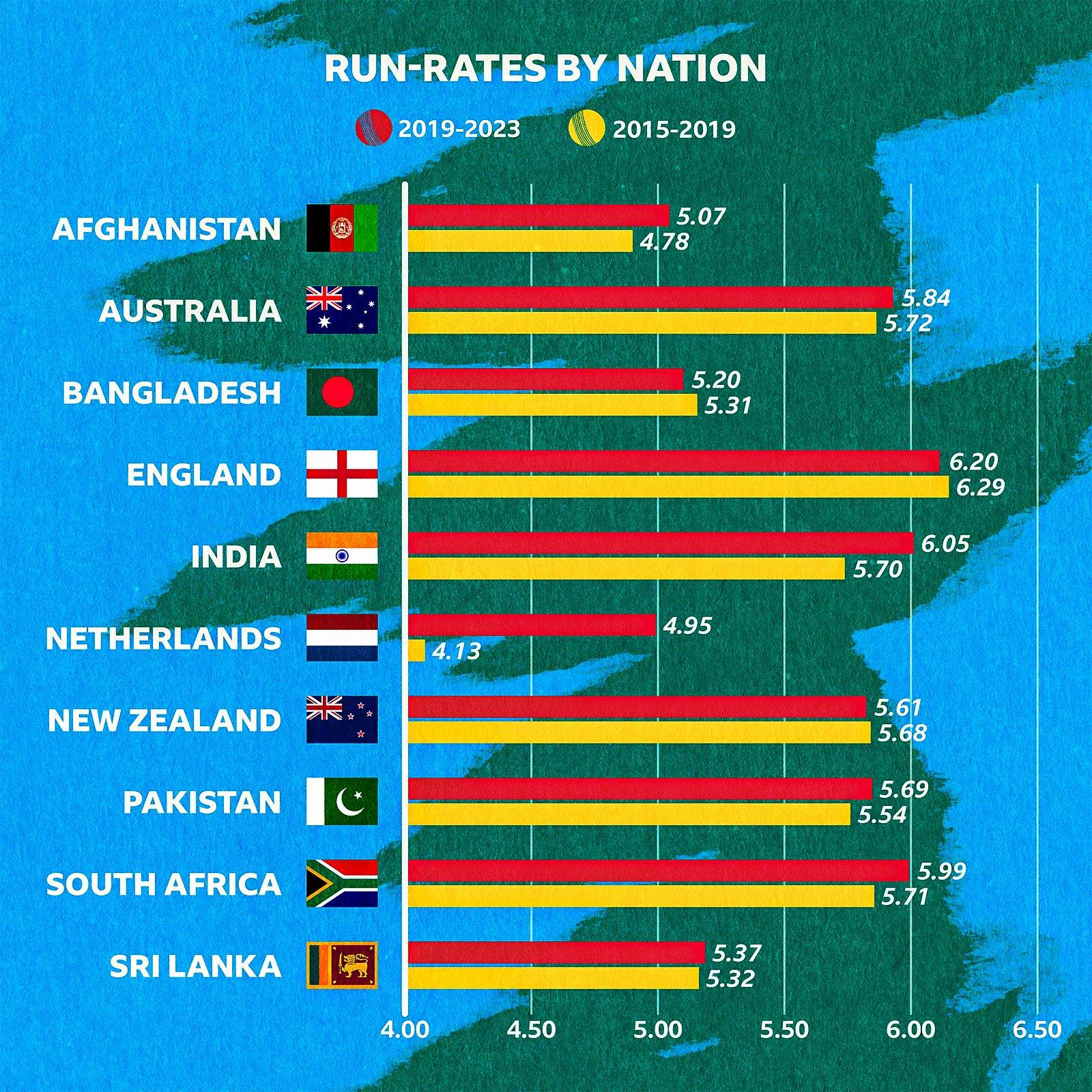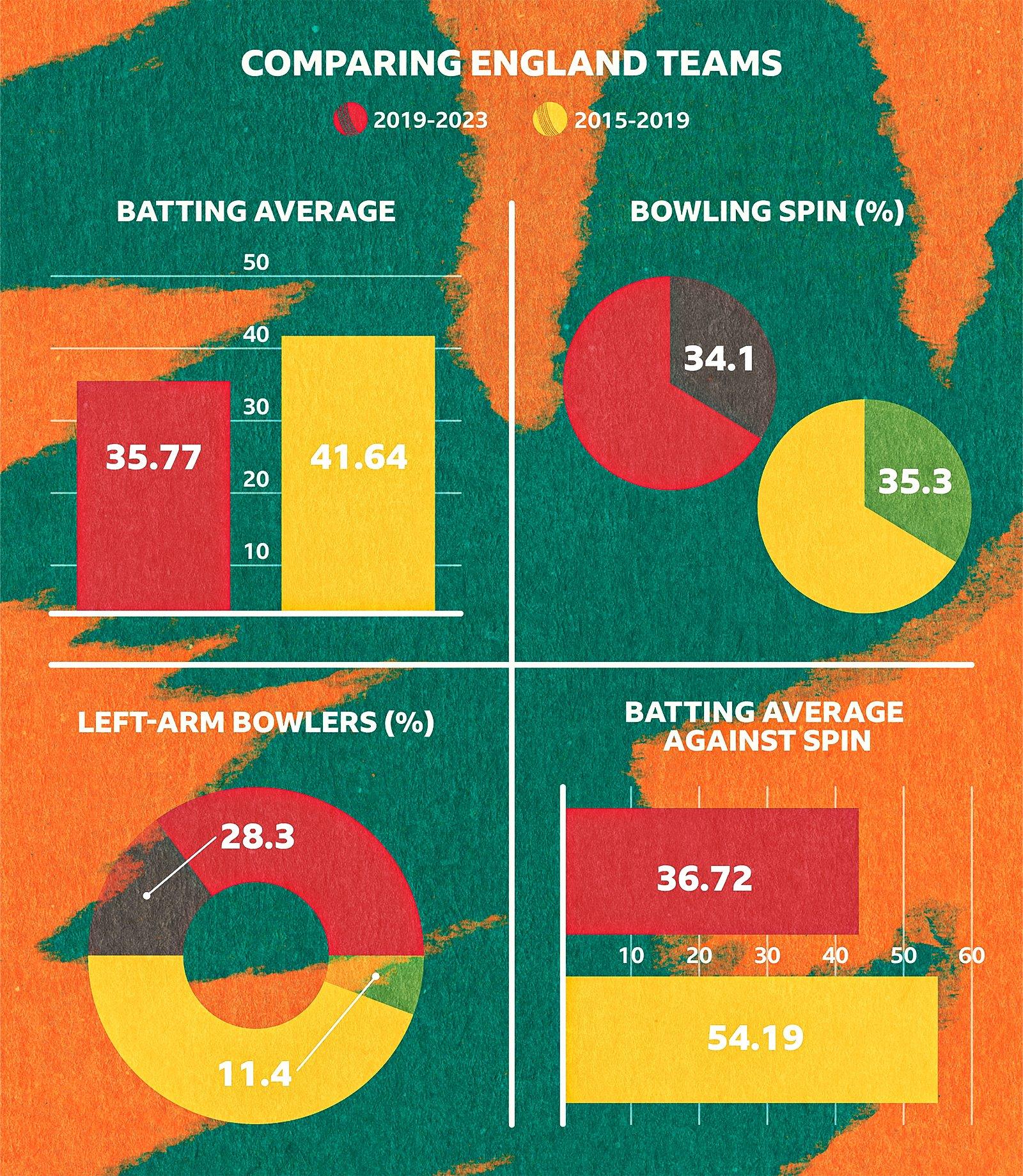Cricket World Cup 2023: Do the stats suggest England can defend title?
- Published

Will England win the World Cup for a second successive time?
England's 2019 Men's Cricket World Cup success is almost distant history in cricketing terms.
Back then, 'Bazball' was just a twinkle in the eye of the recently-retired Brendon McCullum, Ben Stokes' knee was in as good nick as the middle of his bat and Harry Brook was a 20-year-old prospect breaking through into Yorkshire's first team.
Since then, T20 cricket, The Hundred and other white-ball franchise competitions have grown in size and stature, leaving one-day cricket seemingly the poor relation of cricket's three main formats.
But as the world's top cricketers - and us cricket fans, for that matter - recalibrate to 50-over cricket, how much has the format changed since Eoin Morgan's freewheeling England crashed their way to glory?
One-day cricket a distant third in priorities?
Every single nation which has qualified for the last two World Cups has played less one-day cricket in the last four years, than in the previous four-year cycle.
England, for example, have played 42 one-day internationals since becoming the best in the world, compared to 88 in the previous cycle.
There is the caveat of Covid-19 ravaging the cricket calendar for almost two years, but in that same four-year period, England's men have played in two T20 World Cups and three Ashes series.
Only Pakistan, Afghanistan and the Netherlands have played less than England who, in the same timeframe, have played 68 T20 internationals.
Priorities have shifted, of course.
Winning the World Cup in 2019 on home soil was a stated aim, even ahead of Test and T20 cricket at some points.
In recent years, however, Test cricket has regained its status as England's undisputed priority.
Is the gap closing?

When England blazed their way to World Cup glory during a four-year period of domination, built on aggressive batting and with no apparent ceiling on the scores they could compile or chase down, the rest of the world struggled to keep up.
Between the 2015 World Cup and the start of the 2019 campaign, England passed 400 four times, with a dizzying total of 500 seen as inevitable.
They have passed 400 just once in the last four years - against the Netherlands in 2022 when they racked up 498-4.
Perhaps more strikingly, they have passed 300 just 12 times in ODIs since the last World Cup, compared to 38 times between 2015 and 2019.
They are one of just three nations not to have improved their run-rate in the current cycle - Bangladesh and New Zealand being the others - although they and India are the only sides to average more than six an over.
So while their average run-rate has dropped, and others have improved, they still remain ahead of the pack.
But... there's always a but!

Graphic comparing England teams of 2015-2019 and 2019-2023. In summary England are averaging less runs per wicket, and considerably less against spin. The composition of their bowling attack has changed too, with the team now bowling slightly more spin and utilising left-arm pace much more
England have slipped to fifth in the ICC's world rankings - behind India, Pakistan, Australia and South Africa - and while that is not always the best gauge of a team's global standing, it can serve as a rough indicator.
One of the obvious places where they appear to have gone backwards is their ability to dominate leg-spin.
Australia's Adam Zampa and India's Yuzvendra Chahal have enjoyed success against them in recent series' and it's part of a wider and concerning trend, particularly as the World Cup will be held on the spin-friendly pitches of India.
In this cycle, England are averaging just 23 against leg-spin, compared to 59 in the four-year period previous. Against all types of spin, it has dropped to 37, down from 54.
Of the top-performing bowlers (based on wickets taken) for the nine other competing nations, six of them are spinners. England's best is leg-spinner Adil Rashid.

What will World Cup matches in India look like?
It will be a question asked throughout the tournament - what is a good total?
This is, of course, hard to measure because of on-the-day conditions etc, but the average first-innings score in ODIs played in India since the last World Cup is 276.
Teams that have won the toss have won 57% of matches, with 73% of toss winners choosing to chase - despite only 50% of chasing teams emerging victorious.
Perhaps surprisingly, pace bowling has been far more effective than spin in India in this period, accounting for 283 wickets at an average of 32 compared to 142 at 40.
Ok, so who's going to win the World Cup?
Teams with the strongest pace attacks, and whose batters perform best against pace, are likely to go far.
India and Pakistan are in the top three in both metrics, with South Africa's batting against pace the best in the world in this cycle.
The other team with a potent pace attack is perhaps rather surprising: Bangladesh.
They rank second to only Pakistan, with their pace bowlers averaging 27.
Pace the key? | |||
|---|---|---|---|
Country | Batting average versus pace | Country | Pace bowling average |
1. South Africa | 38.56 | 1. Pakistan | 26.58 |
2. India | 38.28 | 2. Bangladesh | 27.12 |
3. Pakistan | 35.57 | 3. India | 28.68 |
4. England | 35.03 | 4. New Zealand | 29.02 |
5. Australia | 32.42 | 5. Sri Lanka | 29.67 |
In summary, if you have India or Pakistan in the workplace sweepstake, you might be in the money.
Stats, which were provided by Cricviz, are up to and including 2 October 2023.